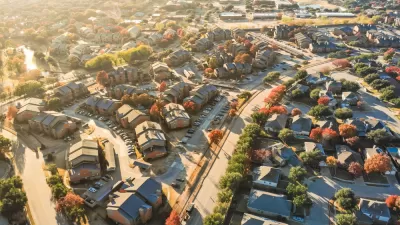The housing shortages caused by restrictive zoning are easy to solve in principle—even if the solutions are politically impossible.

I have written numerous blog posts (for example, here, here and here) about the harms caused by restrictive zoning in the urban context. Such zoning reduces the housing supply in cities, thus increasing housing costs,* which in turn drives people into suburbia, which in turn increases the environmental harms caused by suburban sprawl. But to date, I have not yet suggested a comprehensive remedy to the problem.
I begin with an assumption: when a right or privilege is abused, that right can be taken away. For example, if I abuse my right to carry a firearm by committing felonies, government can prohibit me from possessing a firearm in the future. Similarly, when local governments abused their privilege to create literacy tests for voting (by administering those tests in a racially discriminatory manner) the federal government prohibited the use of literacy tests.
Similarly, some local governments have abused their state-granted right to zone by limiting housing supply; in such situations, state governments should step in and stop the abuse by limiting their right to zone.
Accordingly, I propose that state legislatures pass statutes saying something like this: "Where a city's median sales price exceeds Y times the median household income,** the city, if its population exceeds X people, may not discriminate against housing on the basis of density. Where any housing is allowed, any density of housing is allowed. This law also applies to areas zoned for retail and office use, but not to areas zoned for industry, manufacturing or agriculture. However, the city may enact reasonable height limits, as long as those limits do not prohibit buildings under X stories."
My rule would be limited to larger cities (for example, cities with over 300,000 people) because high housing costs in cities are especially harmful; in addition to reducing regional quality of life, they also accelerate sprawl by encouraging people to move to suburbs in search of cheaper housing. However, a more aggressive legislature could reasonably expand this rule to smaller municipalities, if it believed that the negative effects of high housing costs outweighed the harms caused by sprawl. The rule would be limited to cities with high housing costs because other cities have not abused their zoning privilege to quite the same extent. My version focuses on residential zones because I am willing to accept the common assumption that mixing polluting industry with housing creates a public health menace. By contrast, no such menace exists in office/retail areas.
I added a reference to height limits for two reasons. First, many people who are not afraid of density are opposed to tall buildings, for all sorts of reasons best discussed elsewhere. Second, it seems to me that as long as ten-or twenty-story buildings are allowed, height restrictions alone need not significantly reduce housing supply or density. Mongkok in Hong Kong has 350,000 people per square mile (five times the density of Manhattan)—yet most buildings are only about ten or fifteen stories tall. So if height regulation is limited to true skyscrapers (say, 30 stories and above),*** such regulation will probably not be tremendously harmful (in the context of an otherwise deregulated market).
The traditional "Not In My Back Yard" (NIMBY) arguments against new housing is that new residents increase traffic and change community character. These arguments are wrongheaded because they are essentially "beggar thy neighbor" arguments—if new residents do not create these problems in the city, they will create the same problems somewhere else. For example, suppose a city’s zoning causes 20,000 people to move to suburbs. These people may no longer crowd the streets and subways of the city—but they instead are crowding the roads of the suburbs. In this situation, NIMBY-oriented land use regulation may create a negative-sum game: if these suburbanites drive to jobs in the city, they will create traffic congestion both in the city and in the suburbs, and create regional air pollution by driving more everywhere.
The same is true for the ill-defined idol of "community character." If 20,000 people move to the suburbs, they will change the community character of suburban neighborhoods. In fact, the impact upon community character will be far greater in suburbia; thousands of new residents may change a city neighborhood, but they will change a cornfield even more.
If my bill was enacted, housing supply would eventually rise to meet demand, presumably causing rents and housing prices to go down. In fact, even modest increases in housing supply are holding down rents: for example, rents in Seattle have recently started to decline in response to a surge in vacancies.
*I realize that some people still think that housing supply is unrelated to housing prices; however, I have responded to such arguments here.
**Many commentators seem to think that in a normal housing market, the average house should cost three times median income. So that might be a good place to draw the line.
***30 stories is kind of an arbitrary line, but I suggest it based on my experience living in Manhattan: 10-30 story buildings tend to be for the middle and upper middle classes, where higher buildings tend to be rare and highly luxurious. Having said that, I have not studied the issue in detail.

Depopulation Patterns Get Weird
A recent ranking of “declining” cities heavily features some of the most expensive cities in the country — including New York City and a half-dozen in the San Francisco Bay Area.

California Exodus: Population Drops Below 39 Million
Never mind the 40 million that demographers predicted the Golden State would reach by 2018. The state's population dipped below 39 million to 38.965 million last July, according to Census data released in March, the lowest since 2015.

Chicago to Turn High-Rise Offices into Housing
Four commercial buildings in the Chicago Loop have been approved for redevelopment into housing in a bid to revitalize the city’s downtown post-pandemic.

New Park Opens in the Santa Clarita Valley
The City of Santa Clarita just celebrated the grand opening of its 38th park, the 10.5-acre Skyline Ranch Park.

U.S. Supreme Court: California's Impact Fees May Violate Takings Clause
A California property owner took El Dorado County to state court after paying a traffic impact fee he felt was exorbitant. He lost in trial court, appellate court, and the California Supreme Court denied review. Then the U.S. Supreme Court acted.

How Urban Form Impacts Housing Affordability
The way we design cities affects housing costs differently than you might think.
City of Costa Mesa
Licking County
Barrett Planning Group LLC
HUD's Office of Policy Development and Research
Mpact Transit + Community
HUD's Office of Policy Development and Research
City of Universal City TX
ULI Northwest Arkansas
Town of Zionsville
Write for Planetizen
Urban Design for Planners 1: Software Tools
This six-course series explores essential urban design concepts using open source software and equips planners with the tools they need to participate fully in the urban design process.
Planning for Universal Design
Learn the tools for implementing Universal Design in planning regulations.























